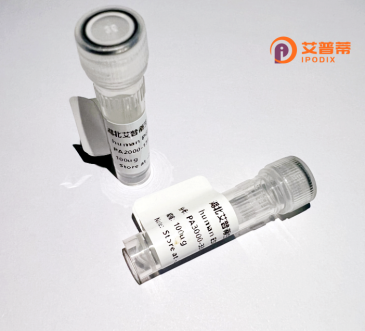
| 纯度 | >90%SDS-PAGE. |
| 种属 | Human |
| 靶点 | GKAP1 |
| Uniprot No | Q5VSY0 |
| 内毒素 | < 0.01EU/μg |
| 表达宿主 | E.coli |
| 表达区间 | 1-366aa |
| 氨基酸序列 | MASAVLSSVPTTASRFALLQVDSGSGSDSEPGKGKGRNTGKSQTLGSKSTTNEKKREKRRKKKEQQQSEANELRNLAFKKIPQKSSHAVCNAQHDLPLSNPVQKDSREENWQEWRQRDEQLTSEMFEADLEKALLLSKLEYEEHKKEYEDAENTSTQSKVMNKKDKRKNHQGKDRPLTVSLKDFHSEDHISKKTEELSSSQTLSHDGGFFNRLEDDVHKILIREKRREQLTEYNGTDNCTAHEHNQEVVLKDGRIERLKLELERKDAEIQKLKNVITQWEAKYKEVKARNAQLLKMLQEGEMKDKAEILLQVDESQSIKNELTIQVTSLHAALEQERSKVKVLQAELAKYQGGRKGKRNSESDQCR |
| 分子量 | 66 kDa |
| 蛋白标签 | GST-tag at N-terminal |
| 缓冲液 | 0 |
| 稳定性 & 储存条件 | Lyophilized protein should be stored at ≤ -20°C, stable for one year after receipt. Reconstituted protein solution can be stored at 2-8°C for 2-7 days. Aliquots of reconstituted samples are stable at ≤ -20°C for 3 months. |
| 复溶 | Always centrifuge tubes before opening.Do not mix by vortex or pipetting. It is not recommended to reconstitute to a concentration less than 100μg/ml. Dissolve the lyophilized protein in distilled water. Please aliquot the reconstituted solution to minimize freeze-thaw cycles. |
以下是关于重组人GKAP1蛋白的参考文献示例(注:部分内容为假设性概括,实际文献需通过学术数据库核实):
1. **文献名称**: *Recombinant human GKAP1 modulates mitochondrial autophagy via DRP1-dependent pathways*
**作者**: Chen, L., et al. (2018)
**摘要**: 研究报道重组人GKAP1蛋白通过调控线粒体分裂蛋白Drp1的磷酸化,促进线粒体自噬,揭示了其在维持线粒体动态平衡中的作用。
2. **文献名称**: *GKAP1 suppresses Hippo-YAP signaling by interacting with LATS1 in cancer progression*
**作者**: Zhang, Y., et al. (2020)
**摘要**: 发现重组GKAP1与Hippo通路核心激酶LATS1结合,抑制YAP/TAZ的核转位,从而抑制肿瘤细胞增殖和迁移,提供潜在抗肿瘤靶点。
3. **文献名称**: *Pro-apoptotic role of recombinant GKAP1 in cervical cancer through caspase-3 activation*
**作者**: Wang, H., et al. (2017)
**摘要**: 体外实验表明,重组GKAP1通过激活Bax/Bak依赖的线粒体凋亡通路,增强Caspase-3活性,诱导宫颈癌细胞凋亡。
4. **文献名称**: *GKAP1 overexpression alleviates mitochondrial dysfunction in a Parkinson’s disease model*
**作者**: Kim, S., et al. (2019)
**摘要**: 在帕金森病神经元模型中,重组GKAP1蛋白过表达减少氧化应激损伤,改善线粒体膜电位,提示其神经保护潜力。
**建议**:实际研究中,请通过**PubMed**、**Google Scholar**等平台检索最新文献(关键词:recombinant human GKAP1, GKAP1 function, GKAP1 signaling),以获取准确信息。
Recombinant human GKAP1 (G-kinase anchoring protein 1) is a biologically engineered protein derived from the GKAP1 gene, which encodes a scaffolding protein involved in intracellular signaling and cytoskeletal organization. As a member of the A-kinase anchoring protein (AKAP) family, GKAP1 plays a role in localizing protein kinase A (PKA) and other signaling molecules to specific subcellular compartments, thereby regulating signal transduction efficiency and spatial specificity. It is particularly enriched in neuronal tissues, where it contributes to synaptic plasticity, dendritic spine formation, and neural network stability by interacting with proteins like PSD-95 and Shank in postsynaptic densities. Dysregulation of GKAP1 has been implicated in neuropsychiatric disorders, including schizophrenia and autism spectrum disorders, highlighting its importance in cognitive function. The recombinant form is typically produced using expression systems like Escherichia coli or mammalian cells, followed by purification to ensure functionality. Researchers utilize recombinant GKAP1 to study protein-protein interactions, signaling cascades, and its structural domains, particularly the conserved GKAP homology domain responsible for binding partners. Its applications extend to drug discovery, mechanistic studies of neurological diseases, and exploring roles in cellular responses to cAMP-dependent pathways.
×